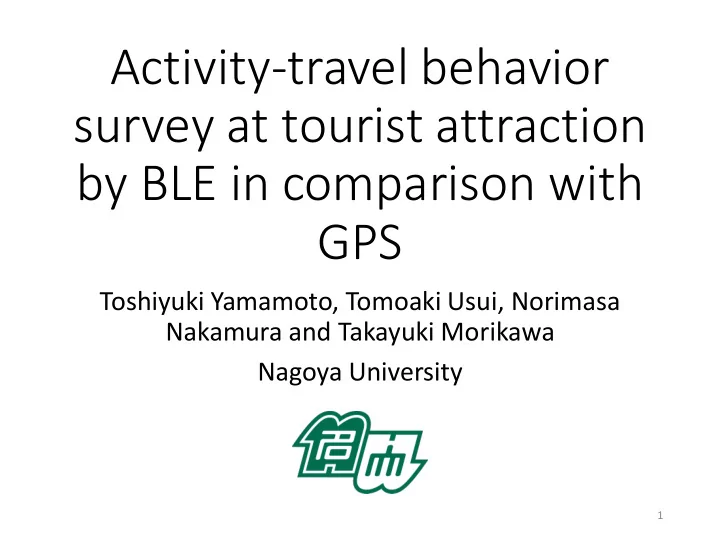

Activity-travel behavior survey at tourist attraction by BLE in comparison with GPS Toshiyuki Yamamoto, Tomoaki Usui, Norimasa Nakamura and Takayuki Morikawa Nagoya University 1
Background • Disaggregate activity-travel behavior data as important resource for tourism research • Traditional questionnaire survey: inaccurate respondent’s memory and burden to answer • Manual tracking by investigator (e.g., Sasaki and Matsui, 1968) • Mobile phone with GPS (e.g., Asakura and Hato, 2004) • Needs for survey cost reduction while keeping accuracy • Human resource for manual tracking • Battery power and signal-lost inside buildings for GPS tracking 2
Potential of Bluetooth • Several studies using Bluetooth technology (e.g., Malinovskiy et al, 2012) • Lower energy consumption than GPS • Capability inside buildings and urban canyons • However, accuracy should be verified • Travel time was investigated in the literature (e.g., Aliari and Haghani, 2012) • How about other dimensions of activity-travel pattern? 3
GPS versus BLE (Bluetooth low energy) Source: Global Positioning System (GPS) 2 nd edition Source: www.libelium.com GPS BLE Type of observation Lagrange : Euler : observation at observation along the stationary points mobile object Location precision High Low Battery consumption High Low 4
Objective To verify accuracy of observed activity-travel patterns by BLE in comparison with GPS • Activity-travel patterns within a park with several sections • Tango Kingdom in Kyoto, Japan • Several dimensions of activity-travel patterns • Number of sections visited, duration of stay at each section, order of visits to each section, etc. 5
Tango Kingdom • Located at Kyoto, Japan • One of the largest roadside stations in western Japan • Started operation at April, 2015 • 34 ha of the land filled with many sections • Market area of fresh vegetables and seafood, restaurants featuring local ingredients, go-cart track, grass slide field, pony rides, etc. 6
Park map Go-cart track 7 Grass slide field
Survey • Date: 2015/08/22(sat), 23(sun) • Respondents: 280 groups of visitors • Carrying both BLE device and GPS logger • Questionnaire survey sheet: purpose of visit, frequency, etc. 8
Demographics of visitors (N=280) Distance from home Group size Up to 30 km Alone 12% 2% Couple 30 to 100+ 32% 100 km km Three+ 30% 58% 66% Number of visits Repeater 21% First timer 79% 9
BLE receivers Go-cart track Food court 500 m Grass slide field 12 BLE receivers 10
Group A GPS BLE BLE (receiving) 11
GPS trajectory of Group A 12
BLE observation of Group A Animal section Plaza Cow shed Clock tower Athletic section Food court Go-kart track Rotary Hotel Belvedere Small animal Grass slide field Very short stay seem false-positive because of receiving signal from long distance 13
Space-time path of Group A GPS BLE 14
Kernel density of Group A GPS (10 m) BLE (50 m) 15
Kernel density of all groups GPS (10 m) BLE (50 m) 16
Comparison of sample average Total duration at Number of Total walking park sections visited distance 140 7 9 8 120 6 7 100 5 6 80 4 5 Minutes Sections Km 4 60 3 3 40 2 2 20 1 1 0 0 0 GPS BLE Effect of false-positive 17
Comparison of sample average Visiting rate for each section 100% Cow Clock 80% Belvedere Hotel shed tower 60% % 40% 20% 0% Grass Go-cart Animal Shopping Plaza Food slide track section zone court field Stay duration at each section 16 14 12 Minutes 10 8 6 4 2 0 GPS BLE Effect of false-positive 18
GPS locations when BLE at grass slide field receives signals At some geographic conditions, BLE signal reaches far longer than assumed 50 m distance 19
Staying duration at each section by distance from home 25 GPS 20 15 10 5 0 Go-cart Animal Clock Cow Grass Food Belvedere Shopping Hotel Plaza track section tower shed slide court zone 25 field BLE 20 15 10 5 0 中距離( 30 ~ 100km ) 遠距離( 100km 以上) 近距離( 30km ) 30 to 100 km Up to 30 km 100+ km 20
Conclusions • BLE can collect the information of visitor’s activity- travel behavior as accurately as GPS • Number of sections visited • Total duration at the attraction • Visiting rate for each section for most sections • Duration at each section for most sections • At some conditions, BLE signal reaches far longer which results in false-positive and lower accuracy • Total walking distance • Need for error cleaning algorithms 21
Recommend
More recommend